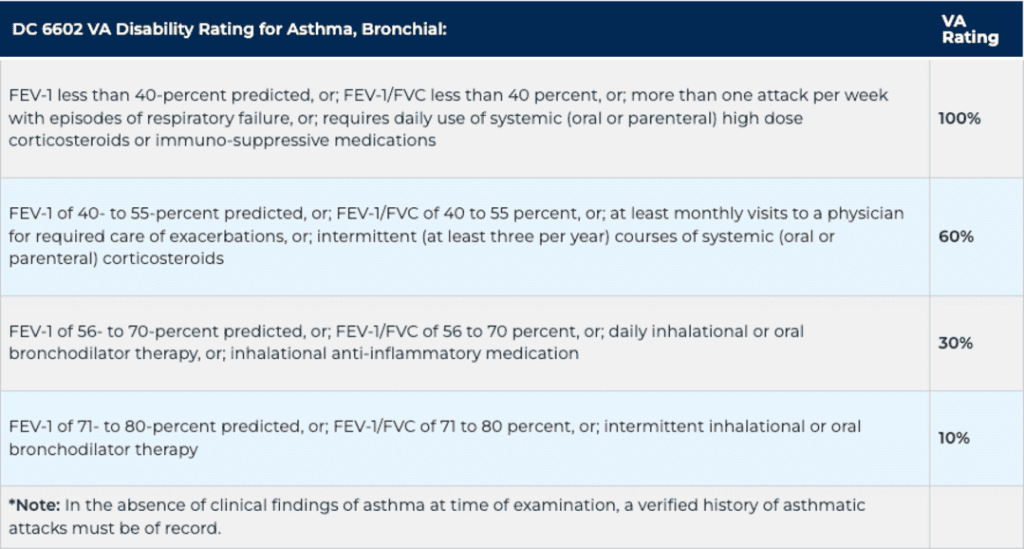Looking for Expert-Level VA Claim Answers?📱Call Us Now! 737-295-2226
In this post, we break down how the VA rates asthma, including the four possible asthma VA ratings. We also examine how to prove service connection, common VA secondary conditions to asthma, and more!
Getting an asthma VA rating may be easier than you know. If you are a veteran who was exposed to toxic substances during your military service, you may qualify for a presumptive asthma VA disability, simplifying the VA claims process.
Let’s get started.
Table of Contents
Summary of Key Points
- Asthma symptoms can range from mild to severe or even life-threatening.
- The VA rates asthma at 10%, 30%, 60% or 100%.
- An asthma VA rating can be considered presumptive (i.e., presumed service-connected), providing you meet specific criteria.
- Several documents can support your VA rating for asthma, such as a medical Nexus Letter, which can be key to a winning claim.

You DESERVE a HIGHER VA rating.
Take advantage of a VA Claim Discovery Call with an experienced Team Member. Learn what you’ve been missing so you can FINALLY get the VA disability rating and compensation you’ve earned for your service.
What is Asthma?
Asthma is a chronic (i.e., long-term) respiratory condition that affects the lungs’ airways. The condition causes inflammation and narrowing of the breathing passages, making breathing difficult. The severity of asthma can range from mild to severe or even life-threatening and often requires ongoing medical treatment.
Types of Asthma
Types of asthma include:
- Exercise-induced asthma, which may be worse when the air is cold and dry
- Occupational asthma, triggered by workplace irritants such as chemical fumes, gases, or dust
- Allergy-induced asthma is commonly triggered by airborne allergens, such as pollen, mold spores, cockroach waste, skin particles, and pet dander.
Symptoms
For some veterans, asthma is a minor inconvenience. For others, it can be a significant problem that interferes with daily activities (e.g., work, life, and social functioning) and may even involve the need for emergency medical intervention.
According to the Mayo Clinic, asthma involves narrowing and swelling of airways, often producing excess mucus. This can make breathing difficult and trigger coughing, wheezing, and shortness of breath.
Asthma symptoms can vary in frequency and intensity.
Common asthma symptoms include:
- Shortness of breath
- Chest pain or tightness
- A whistling or wheezing sound while breathing
- Persistent coughing, which is more severe at night or early morning
- Trouble sleeping caused by coughing, wheezing, or shortness of breath
- Flare-ups (i.e., coughing or wheezing attacks) worsened by respiratory colds or the flu
Environmental factors, allergens, and physical exertion can aggravate asthma symptoms and cause flare-ups.
Asthma VA Ratings
The VA considers asthma a bronchial (i.e., airway passages that lead to the lungs) disorder, with the assigned diagnostic Code (DC) 6602, “asthma, bronchial.” Asthma is commonly rated under CFR 38, Part 4, VA Schedule of Ratings.
An asthma VA rating can be 10%, 30%, 60%, or 100%, depending upon several factors, including:
- The frequency of asthma attacks
- How often medical intervention is required to manage asthma symptoms
- Pulmonary Function Test (PFT) results which measures your lung capacity as FEV-1 and FVC ratios
- Asthma medication requirements (e.g., inhalational therapy [e.g., inhalers and nebulizers], systemic corticosteroids [e.g., prednisone or dexamethasone], or oxygen therapy)
Asthma VA Rating Tables
Qualifications for each rating can be met by meeting a particular breathing function test result or the specific frequency of asthma medication use.
| VA RATING | Pulmonary Function Test Results | Asthma Medication | Doctor’s Visits for Medical Management |
| 10% | FEV-1 of 71- to-80 percent predicted, or FEV-1/FVC of 71 to 80 percent | (Or) intermittent inhalational or oral bronchodilator therapy | N/A |
| 30% | FEV-1 of 56- to-70 percent predicted, or FEV-1/FVC of 56 to 70 percent | (Or) daily inhalational or oral bronchodilator therapy or; inhalational anti-inflammatory medication | N/A |
| 60% | FEV-1 of 40- to 55-percent predicted, or; FEV-1/FVC of 40 to 55 percent, or; | (Or) intermittent (at least three per year) courses of systemic (oral or injectable) corticosteroids | (Or); at least monthly visits to a physician for required care of exacerbations (i.e., flare-ups) |
| 100% | FEV-1 less than 40 percent predicted, or FEV-1/FVC less than 40 percent, or | (Or) requires daily use of systemic (by mouth, IV, or via injection) high-dose corticosteroids or immuno-suppressive medication | (Or): more than one attack per week with episodes of respiratory failure |
Note: If you do not have active symptoms of asthma during your exam, a medical history of asthma attacks must be on record.

Proving Service Connection
The VA uses the term service connection when describing a disability caused by (or worsened by) military service.
If you don’t meet the PACT Act requirements because you didn’t serve in specific geographic areas (such as Southwest Asia after September 11, 2001), or for other reasons, you must prove your asthma is service-connected by satisfying the elements of service connection.
To prove service connection you need:
1. A current Medical Diagnosis of Asthma
2. Evidence of an In-Service Event, Injury, Disease, or Aggravation
3. A nexus (link) between #1 and #2 via Competent Medical Evidence (can be a nexus letter)
Asthma VA Rating: PACT Act
You may qualify for an asthma presumptive service connection for veterans who served in the Persian Gulf or specific regions of Southwest Asia under the PACT Act.
The PACT Act provides eligibility for veterans who develop certain medical conditions—including asthma— “presumed” to be caused by toxic substances, such as those emitted by burn pits, chemicals (e.g., Agent Orange), or environmental hazards (e.g., prolonged exposure to sandstorms or other airborne hazards) during military service.
If you meet the requirements for a presumptive condition under the PACT Act, you won’t need to prove service connection. However, there are specific criteria you must meet to qualify.
Related: Updated PACT Act Presumptive Conditions & Maximizing Your PACT Act Compensation
VA Secondary Conditions to Asthma
Other medical conditions, called “secondary conditions,” can be caused or exacerbated (i.e., worsened) by asthma.
If you have a secondary condition proven to be linked with your service-connected asthma, you may qualify for an increase in VA disability benefits.
Common conditions secondary to asthma include:
- GERD (gastrointestinal reflux disease) – commonly known as acid reflux or heartburn; due to increased pressure on the diaphragm, asthma and GERD (DC code 7206) commonly occur together.
- Obstructive Sleep Apnea – severe long-term upper airway inflammation and narrowing can contribute to the collapse of the upper airway during sleep, worsening or causing sleep apnea (DC 6847).
- Allergies – inflammation caused by asthma can exacerbate (i.e., worsen) existing allergies (DC 6522).
- Vocal Cord Dysfunction (Inducible Laryngeal Obstruction)
- Asthma-COPD overlap syndrome – long-term inflammation caused by asthma can lead to chronic obstructive pulmonary disease (COPD, DC code 6604) or Asthma-COPD overlap syndrome (ACOS) through airway remodeling. Airway remodeling involves thickened and narrow airways that can lead to irreversible loss of lung function.
- Type 2 Diabetes – chronic inflammation from asthma can increase insulin resistance, which contributes to the development of type 2 diabetes (DC code 7913).
- Anxiety and Depression – having a chronic disorder, like asthma, can influence your mental health and cause or worsen conditions such as anxiety (DC 9400) or depression (DC 9434).
Filing a VA Claim for Asthma Disability
You can file your claim online, via fax, mail, or in person at your local VA center. You must download and complete the VA Form 21-526EZ for claims not filed online.
In Summary
Asthma can profoundly impact your quality of life, but obtaining an asthma VA rating can provide VA disability compensation and benefits. The first steps in getting rated for a VA disability for asthma include learning how the VA rates asthma, establishing a service connection and filing a VA disability claim.
(FAQs) Frequently Asked Questions
Is asthma a presumptive VA disability?
Yes. Asthma may be considered a presumptive disability for veterans who meet the PACT Act requirements, such as serving in specific geographic locations (e.g., Southwest Asia) after September 11, 2001.
What is the highest asthma VA rating?
The highest VA rating for asthma is 100%.
How can I get rated for a 100% VA disability for asthma?
To get a 100% asthma VA rating, the VA requires that you have over one asthma flareup per week with episodes of respiratory failure, or FEV-1 less than 40% predicted or FEV-1/FVC less than 40%, or you need high dosages of corticosteroids or immunosuppressive medications daily.
What evidence do I need for a successful VA disability claim?
A current medical diagnosis, in-service exposure, and a strong nexus letter are items known to result in a successful VA disability claim.
Want Expert-Level Support for Your VA Disability Claim? WE GOT YOUR SIX!

- VA Claims Insider is the #1 most trusted name in VA disability claims.
- Work directly with a VA claims coach who can educate you to VA claim victory.
- 25,000+ disabled veterans served in our membership programs since 2016.
- 30% average rating increase for veterans who complete our #1 rated Elite program.
- 4.7/5.0 average rating out of 5,500+ total reviews; over 4,500 5-star reviews.
Author

Sherry Christiansen
Sherry Christiansen is a professional Medical Writer with a clinical mental health background. Over the last decade, she has written health and wellness articles for organizations like Medical News Today, Verywell Health, and Healthline. In 2013, she also helped launch an educational website for the first Alzheimer’s prevention clinic in the country at Weill Cornell Medical Center – NewYork-Presbyterian. As a spouse of a career military service member, Sherry is deeply passionate about supporting veterans. It is an honor for her to assist veterans in receiving the benefits they deserve after becoming ill or injured while serving our country.



